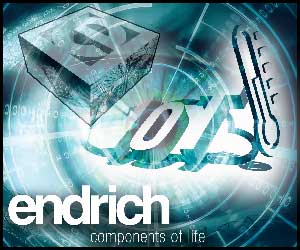Energy-efficient components support climate protection
Megjelent: 2023. június 27.
 Developing devices to EU Ecodesign Directive 2009/125/EC
Developing devices to EU Ecodesign Directive 2009/125/EC
Climate protection is something that concerns us all. Nevertheless, climate objectives can only be achieved with even more efficient electronic devices. The EU has set out the minimum requirements for energy-related products in its Ecodesign Directive. Innovative components help to meet them.
Roughly, one-quarter of the total power consumption in Germany in 2018 was attributable to private households. At 129 terawatt hours, the figure was still 7.2% less than 2008 (source: German Environment Agency (UBA)). This decline is due in part to various consumer labels such as the Blue Angel eco-label and the EU energy label with energy efficiency classes on a scale from A+++ to G. Further, the energy efficiency standards set out in the EU Ecodesign Directive 2009/125/EC contribute to energy savings.
The aim of the Ecodesign Directive is to improve the environmental performance of energy-related products throughout their whole life cycle. To this end, it stipulates mandatory requirements for devices that have a significant environmental impact “in accordance with Community environmental priorities, such as those set out in Decision No. 1600/2002/EC”. In addition, the devices must demonstrate significant potential for improvement in terms of their impact on the environment without entailing excessive costs, and their annual sales in the EU market should exceed 200,000 units.
Household appliances such as refrigerators and freezers, dishwashers and washing machines, electric hot plates, microwave ovens and electric ovens, smart home devices, and consumer electronics, but also PCs, electric motors, and welding equipment are thus affected.
There is also the EU Standby Regulation, which spells out the eco-design requirements for the electric power consumption of electrical and electronic household appliances and office equipment in standby and off modes. For example, according to the said directive, the power consumption of large household appliances, such as hot plates, ovens, or even television sets, must not in any condition exceed 0.5 W in standby mode and off mode, and 1 W when displaying information or status.
With the aid of appropriate components, Rutronik supports its customers in developing energy-efficient devices that meet these requirements. A few examples:
LDO voltage regulator with switch-off pin
A low dropout regulator (LDO regulator) is a linear DC voltage regulator that can regulate the output voltage even when the supply voltage hardly differs from the output voltage. An LDO regulator works very efficiently as it can be switched off when not required, thus helping to save power. This makes it ideal for devices that are frequently in standby mode and for applications whose output voltage needs to be regulated only slightly below the input voltage.
Compared to other clocked DC/DC regulators, LDO regulators have a number of other advantages to offer. The linear operation of the LDO regulators does away with the need for switched transistors, which would otherwise generate noise and interference. They do not require inductors and transformers, thereby allowing for smaller devices and less complex designs. However, unlike switching regulators, they do dissipate power or heat via the control unit.
When using switching regulators, an LDO regulator is often added to the output as an active filter. Especially for applications in the field of measurement and sensor technology, low-noise and interference-free power supplies are essential, e.g. for high-resolution ADCs and DACs or precision OPAMPs. This is because, on their own, they are hardly able to achieve the low output ripple necessary for a strict noise specification. In this case, LDO regulators with a high power supply rejection ratio (PSRR) between the input and output side in accordance with the switching frequency of the upstream switching regulator are recommended.
PSRR is one of the key parameters affecting the behavior of LDO regulators. It indicates the extent to which the LDO regulator is able to reduce fluctuations on the output side caused by the variable input voltage. The following applies:
PSRR = 20 log10•Vin/Vout
Other important parameters are the dropout voltage and the quiescent current. The dropout voltage is the difference between the input and output voltages required for internal regulation at the exact point where the output voltage can no longer be regulated when the input voltage continues to fall. The quiescent current of an LDO regulator is composed of its feedback and drive current. The lower the quiescent current and dropout voltage, the greater the efficiency of the LDO regulator.
Boosting battery life with LDO regulators
An LDO regulator can be a very effective means of increasing energy efficiency in a battery system by minimizing power consumption in standby mode. The new LDI8119EN voltage regulator from Diotec (Fig. 1), which can switch off the system in standby mode via an enable function, is ideally suited for this purpose. The enable input (EN) uses an external signal to switch the battery system on and off. If the regulator is deactivated, the internal band-gap reference continues to run, thus allowing fast switch-on times.
If the LDO regulator is switched off, the input current is usually limited to 1 µA. This shutdown current should not be confused with the quiescent current, i.e. the current consumed by the switched-on device with no load. Both shutdown current and quiescent current are key parameters for the battery life. The following formula is used to calculate the power loss or power dissipation (PD):
PD = (Vin – Vout) ∙ Iout + (Vin ∙ IQ)
With no load on the LDO regulator, i.e. the output current is 0 A, the quiescent current (IQ) is the decisive parameter for power dissipation. It is responsible for almost half of the total power dissipation.
This means that in applications where the device is predominantly operated in idle mode, the quiescent current plays a key role and must be taken into account during the design process.
LDI8119EN from Diotec has a particularly low quiescent current of just 60 µA. With a shutdown current of 0.4 µA to 1.0 µA, it is well-suited to all battery management applications. This simple component can significantly increase the efficiency of the battery system and boost battery life.
Figure 1: Thanks to its enable function, Diotec’s LDI8119EN LDO regulator uses an external signal to switch the system on and off.
Zener diode with a test current of just 50 µA
Zener diodes typically operate in the low mA range, thereby consuming several milliwatts of power. However, this may be too much to comply with the Ecodesign Directive. In contrast, the MMS1ZXX and MMSZXX diodes from Diotec and Panjit operate at just 50 µA, thus helping to reduce overall power consumption (Fig. 2). They are usually used for voltage stabilization and regulation. In the standard version, the tolerance of the Z-voltage is graded according to the international series E24 (±5%). Other tolerances and higher operating voltages are available on request. The maximum power dissipation of the diodes is 500 mW. They also have a low reverse current and a flat design.

Figure 2: The MM1Z4711 Zener diode from Diotec operates at just 50 µA, thus helping to reduce the overall power consumption of devices.
Fast rectifier diodes for more energy efficiency
In the power electronics market, rectifier diodes have a decisive influence on the performance of the overall system, e.g. in PFC circuitry (power factor correction) and applications such as motor controllers, inverters, as well as bridge and DC/DC converters. When looking at which components produce the most heat when operating these systems, the rectifier diodes are usually top of the list.
However, selecting the ideal rectifier diode is not an easy task. Since each diode technology has its advantages and disadvantages, and each application needs to meet individual requirements, some of which contradict each other (Fig. 3). To be able to offer the ideal diode for every application, Rutronik has access to a broad product portfolio of diodes with varying technologies.
When it comes to energy efficiency, the ES1G Superfast Efficient rectifier diode, e.g. from the suppliers Panjit, Diotec, and Diodes, should be first choice. It is suitable for circuitry that operate at high frequencies, such as switched-mode power supplies. Beside conduction losses, there are also switching losses proportional to the switching time. Since total losses are the sum of conduction and switching losses, both of these parameters must be taken into account when selecting a suitable diode. For circuitry operating at low kHz frequency and with current ratings of a few amperes or more, a fast diode with low forward voltage is recommended. For circuitry operating up to a few 100 kHz, the focus is on a diode with a short switching time. Ideally, the diode combines low forward voltage and short switching time, just like ES1G. This helps to significantly reduce the power dissipation and thus the system’s power consumption.
Schottky diode with low reverse current and flux voltage
For appliances that are constantly in use, such as hot plates or microwave ovens, the key is to save every milliwatt of power to meet the requirements of the Ecodesign Directive. Boasting a reverse current below the industry standard and a low forward voltage, Diotec’s SK34SMA L217 15MQ040N Schottky diode ticks all the boxes. It is also responsible for rectification of the power supply. Furthermore, it is also perfect as an output rectifier for the wireless charging of battery-powered devices. Due to its lower leakage currents, it additionally enables longer standby periods.
How does it achieve this? Until now, forward voltage and residual reverse current were considered the main parameters for Schottky diodes. They are interrelated: If the forward voltage is reduced, the residual reverse current increases and vice versa.
There is, however, still a prevailing assumption that the forward voltage is the main contributor to power dissipation, while the residual reverse current is of lesser importance. That is not true in every case. An example: If the output voltage of a boost converter is much greater than the input voltage, the duty cycle will be very long. The longer the cycle, the longer the Schottky diode remains reverse-biased and the greater the reverse losses. Therefore, when dimensioning and selecting the appropriate Schottky diodes, it is essential to analyze the operating conditions in the application or task at hand in detail in advance. The overall losses are, therefore, the sum of the switching, conduction, and reverse losses.
Figure 3: Each diode technology has its specific strengths and weaknesses; and it is not possible to achieve the ideal state with any of them.
Summary
The examples show that innovative components can contribute significantly to the development of more energy-efficient devices that meet the requirements of the Ecodesign Directive. Moreover, they thus make an active contribution to climate protection.
Rutronik Magyarország Kft.
1117 Budapest
Alíz utca 1.
Tel.:+36 1 231 3349
E-mail:Ez az e-mail-cím a szpemrobotok elleni védelem alatt áll. Megtekintéséhez engedélyeznie kell a JavaScript használatát.
#018ed3




















